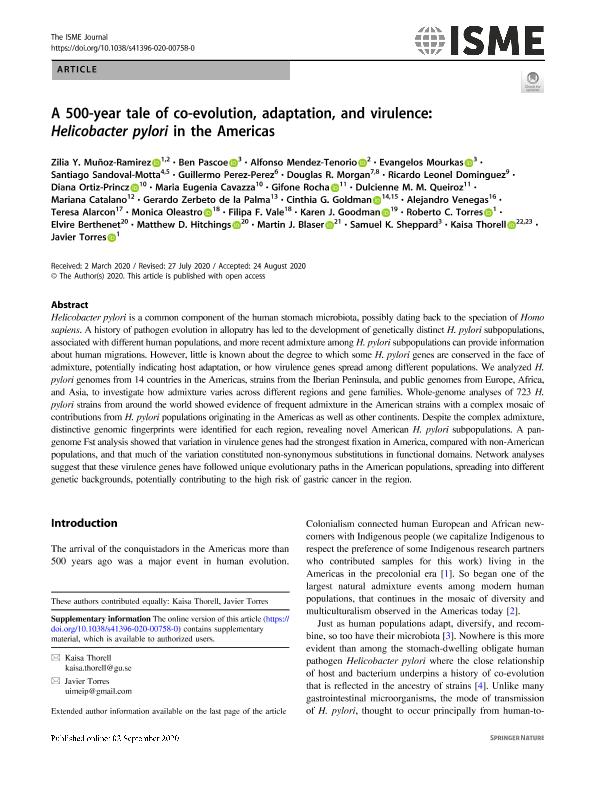Artículo
A 500-year tale of co-evolution, adaptation, and virulence: Helicobacter pylori in the Americas
Muñoz Ramirez, Zilia Y.; Pascoe, Ben; Mendez Tenorio, Alfonso; Mourkas, Evangelos; Sandoval Motta, Santiago; Perez Perez, Guillermo; Morgan, Douglas R.; Dominguez, Ricardo Leonel; Ortiz Princz, Diana; Cavazza, Maria Eugenia; Rocha, Gifone; Queiroz, Dulcienne; Catalano, Mariana; Zerbetto de Palma, Gerardo Gabriel ; Goldman, Cinthia Gabriela
; Goldman, Cinthia Gabriela ; Venegas, Alejandro; Alarcon, Teresa; Oleastro, Monica; Vale, Filipa F.; Goodman, Karen J.; Torres, Roberto C.; Berthenet, Elvire; Hitchings, Matthew D.; Blaser, Martin J.; Sheppard, Samuel K.; Thorell, Kaisa; Torres, Javier
; Venegas, Alejandro; Alarcon, Teresa; Oleastro, Monica; Vale, Filipa F.; Goodman, Karen J.; Torres, Roberto C.; Berthenet, Elvire; Hitchings, Matthew D.; Blaser, Martin J.; Sheppard, Samuel K.; Thorell, Kaisa; Torres, Javier
 ; Goldman, Cinthia Gabriela
; Goldman, Cinthia Gabriela ; Venegas, Alejandro; Alarcon, Teresa; Oleastro, Monica; Vale, Filipa F.; Goodman, Karen J.; Torres, Roberto C.; Berthenet, Elvire; Hitchings, Matthew D.; Blaser, Martin J.; Sheppard, Samuel K.; Thorell, Kaisa; Torres, Javier
; Venegas, Alejandro; Alarcon, Teresa; Oleastro, Monica; Vale, Filipa F.; Goodman, Karen J.; Torres, Roberto C.; Berthenet, Elvire; Hitchings, Matthew D.; Blaser, Martin J.; Sheppard, Samuel K.; Thorell, Kaisa; Torres, Javier
Fecha de publicación:
09/2020
Editorial:
Nature Publishing Group
Revista:
Isme Journal
ISSN:
1751-7362
Idioma:
Inglés
Tipo de recurso:
Artículo publicado
Clasificación temática:
Resumen
Helicobacter pylori is a common component of the human stomach microbiota, possibly dating back to the speciation of Homo sapiens. A history of pathogen evolution in allopatry has led to the development of genetically distinct H. pylori subpopulations, associated with different human populations, and more recent admixture among H. pylori subpopulations can provide information about human migrations. However, little is known about the degree to which some H. pylori genes are conserved in the face of admixture, potentially indicating host adaptation, or how virulence genes spread among different populations. We analyzed H. pylori genomes from 14 countries in the Americas, strains from the Iberian Peninsula, and public genomes from Europe, Africa, and Asia, to investigate how admixture varies across different regions and gene families. Whole-genome analyses of 723 H. pylori strains from around the world showed evidence of frequent admixture in the American strains with a complex mosaic of contributions from H. pylori populations originating in the Americas as well as other continents. Despite the complex admixture, distinctive genomic fingerprints were identified for each region, revealing novel American H. pylori subpopulations. A pan-genome Fst analysis showed that variation in virulence genes had the strongest fixation in America, compared with non-American populations, and that much of the variation constituted non-synonymous substitutions in functional domains. Network analyses suggest that these virulence genes have followed unique evolutionary paths in the American populations, spreading into different genetic backgrounds, potentially contributing to the high risk of gastric cancer in the region.
Archivos asociados
Licencia
Identificadores
Colecciones
Articulos(IMPAM)
Articulos de INSTITUTO DE INVESTIGACIONES EN MICROBIOLOGIA Y PARASITOLOGIA MEDICA
Articulos de INSTITUTO DE INVESTIGACIONES EN MICROBIOLOGIA Y PARASITOLOGIA MEDICA
Articulos(IQUIFIB)
Articulos de INST.DE QUIMICA Y FISICO-QUIMICA BIOLOGICAS "PROF. ALEJANDRO C. PALADINI"
Articulos de INST.DE QUIMICA Y FISICO-QUIMICA BIOLOGICAS "PROF. ALEJANDRO C. PALADINI"
Articulos(OCA HOUSSAY)
Articulos de OFICINA DE COORDINACION ADMINISTRATIVA HOUSSAY
Articulos de OFICINA DE COORDINACION ADMINISTRATIVA HOUSSAY
Citación
Muñoz Ramirez, Zilia Y.; Pascoe, Ben; Mendez Tenorio, Alfonso; Mourkas, Evangelos; Sandoval Motta, Santiago; et al.; A 500-year tale of co-evolution, adaptation, and virulence: Helicobacter pylori in the Americas; Nature Publishing Group; Isme Journal; 15; 1; 9-2020; 78-92
Compartir
Altmétricas



